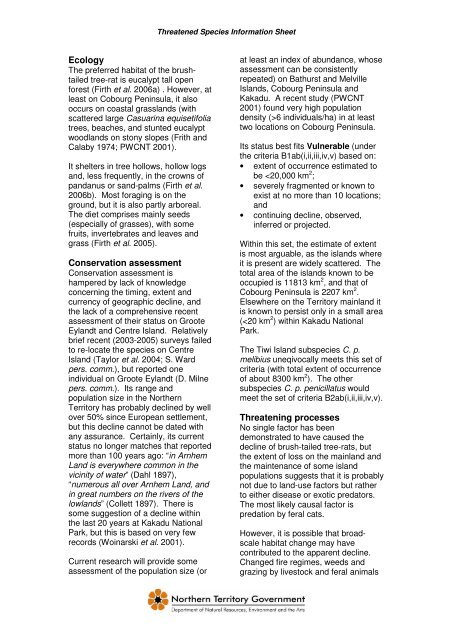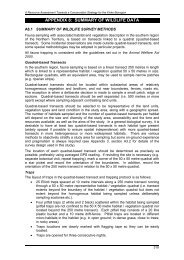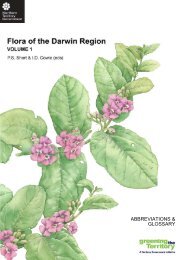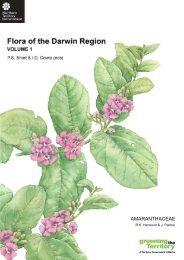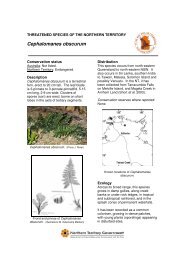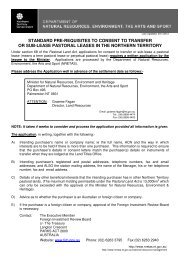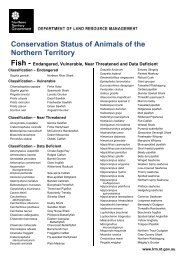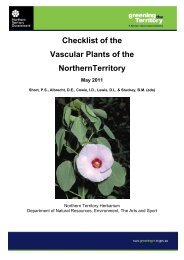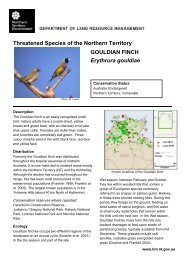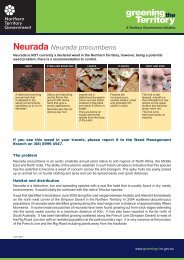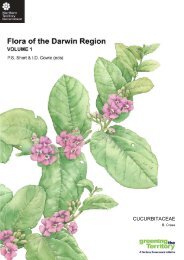BRUSH-TAILED RABBIT-RAT BRUSH-TAILED TREE-RAT ...
BRUSH-TAILED RABBIT-RAT BRUSH-TAILED TREE-RAT ...
BRUSH-TAILED RABBIT-RAT BRUSH-TAILED TREE-RAT ...
Create successful ePaper yourself
Turn your PDF publications into a flip-book with our unique Google optimized e-Paper software.
Ecology<br />
The preferred habitat of the brushtailed<br />
tree-rat is eucalypt tall open<br />
forest (Firth et al. 2006a) . However, at<br />
least on Cobourg Peninsula, it also<br />
occurs on coastal grasslands (with<br />
scattered large Casuarina equisetifolia<br />
trees, beaches, and stunted eucalypt<br />
woodlands on stony slopes (Frith and<br />
Calaby 1974; PWCNT 2001).<br />
It shelters in tree hollows, hollow logs<br />
and, less frequently, in the crowns of<br />
pandanus or sand-palms (Firth et al.<br />
2006b). Most foraging is on the<br />
ground, but it is also partly arboreal.<br />
The diet comprises mainly seeds<br />
(especially of grasses), with some<br />
fruits, invertebrates and leaves and<br />
grass (Firth et al. 2005).<br />
Conservation assessment<br />
Conservation assessment is<br />
hampered by lack of knowledge<br />
concerning the timing, extent and<br />
currency of geographic decline, and<br />
the lack of a comprehensive recent<br />
assessment of their status on Groote<br />
Eylandt and Centre Island. Relatively<br />
brief recent (2003-2005) surveys failed<br />
to re-locate the species on Centre<br />
Island (Taylor et al. 2004; S. Ward<br />
pers. comm.), but reported one<br />
individual on Groote Eylandt (D. Milne<br />
pers. comm.). Its range and<br />
population size in the Northern<br />
Territory has probably declined by well<br />
over 50% since European settlement,<br />
but this decline cannot be dated with<br />
any assurance. Certainly, its current<br />
status no longer matches that reported<br />
more than 100 years ago: “in Arnhem<br />
Land is everywhere common in the<br />
vicinity of water” (Dahl 1897),<br />
“numerous all over Arnhem Land, and<br />
in great numbers on the rivers of the<br />
lowlands” (Collett 1897). There is<br />
some suggestion of a decline within<br />
the last 20 years at Kakadu National<br />
Park, but this is based on very few<br />
records (Woinarski et al. 2001).<br />
Current research will provide some<br />
assessment of the population size (or<br />
Threatened Species Information Sheet<br />
at least an index of abundance, whose<br />
assessment can be consistently<br />
repeated) on Bathurst and Melville<br />
Islands, Cobourg Peninsula and<br />
Kakadu. A recent study (PWCNT<br />
2001) found very high population<br />
density (>6 individuals/ha) in at least<br />
two locations on Cobourg Peninsula.<br />
Its status best fits Vulnerable (under<br />
the criteria B1ab(i,ii,iii,iv,v) based on:<br />
• extent of occurrence estimated to<br />
be


